California’s giant sequoias are burning up. Will logging save them?
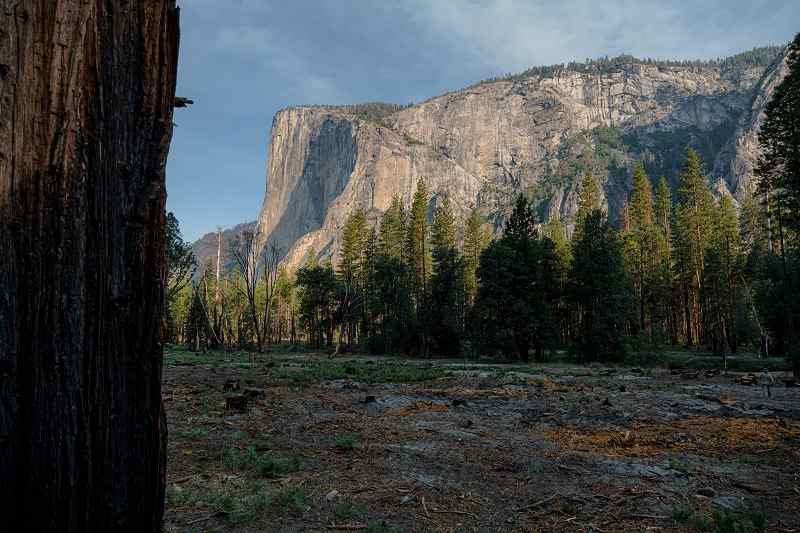
In front of El Capitan, a patch of forest in Yosemite National Park recently underwent a prescribed burn and logging, intended to restore a historic view.
14:46 JST, August 18, 2022
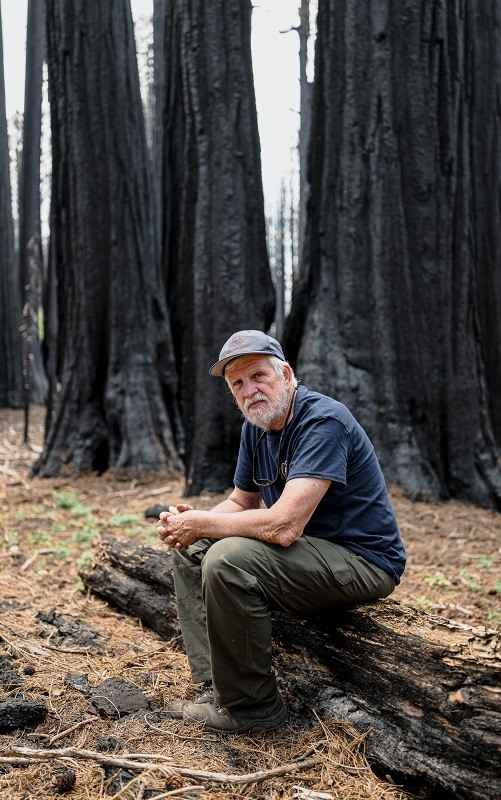
Fire ecologist for the National Park Service, Tony Caprio, in a patch of burned forest called Sugar Bowl in Kings Canyon National Park.
KINGS CANYON NATIONAL PARK, Calif. – Every June, Tony Caprio and his wife Linda hike into the Sugarbowl – a cluster of giant sequoias high in the Sierra Nevada – to admire the profusion of wildflowers and walk among some of the oldest and tallest trees on the planet.
Now when he visits, he sees something that, scientists say, has no precedent in thousands of years of history: vast acres of dead sequoias, killed by fire.
The Sugarbowl, an amphitheater of solemn and enormous trees, part of the Redwood Mountain grove, one of the largest collections of giant sequoia on Earth, has become a graveyard. Trees that have lived since the Roman empire stand as fire-blackened matchsticks, their once bushy green crowns shriveled into charred fists. When the KNP Complex fire roared through last October, it burned so hot in some places that Caprio expects few seedlings to rise from the ash.
“These are all dead,” said Caprio, the fire ecologist for Sequoia and Kings Canyon National Parks, wandering among the grove now closed to the public. “So what’s going to be the long term prognosis for an area like this? Is it going to come back as a shrub field?”
Summer wildfires, in the era of climate change, mean something different now for giant sequoias. These trees evolved with fire, and need it to reproduce, but the scale of recent megafires – burning in hotter, dryer conditions across far greater areas – have overwhelmed many of the groves tucked high in the California mountains. Six of the seven largest wildfires in California history have occurred in the past two years, and in that period, up to nearly one fifth of all naturally-occurring large giant sequoias on Earth have been killed.
“What is new and shocking is these large areas, one hundred acres or more, where every single sequoia is killed,” said Nate Stephenson, an emeritus scientist in forest ecology at the U.S. Geological Survey. “There is no evidence anything like that has happened in the past one thousand years, probably many thousands of years.”
“We’re in a whole new ballgame,” he said.
And in this new game, the rules are in dispute.
The question of how to protect the remaining sequoias, and more broadly how to manage America’s remaining forests in an era of climate-magnified megafires, has divided scientists and the public. The two wildfires that burned in and around Yosemite National Park this summer – including among the famous Mariposa Grove of sequoias – rekindled the debate about what humans can or should do to protect these iconic trees.
Across the parched West, the Biden administration and its public land managers want to dramatically ramp up controlled fires and logging as a way to thin out fuel-packed forests and avoid deadly wildfires. Earlier this year, the Biden administration announced a decade-long, $50 billion plan to use logging and prescribed fire across 50 million acres in 11 Western states to manage wildfire.
Late last month, the U.S. Forest Service said it would take emergency action, including setting fires and cutting down trees, to try to protect a dozen sequoia groves over more than 13,000 acres. Legislation proposed in June, called the Save Our Sequoias Act, would fast-track environmental reviews for these types of logging-and-fire work in the name of fire prevention.
The scale of what some foresters and researchers are calling for in places such as the Sierra Nevada amounts to a wholesale re-engineering of the forest. They say the land management policy that prevailed during much of the 20th century – of putting out most wildfires – has led to overgrown forests. During the past two decades, as climate change has intensified, drought in the West has killed many of those trees, leaving downed logs and dead snags – the “fuels” that firefighters say create hotter and more destructive wildfires.
Before colonists settled the West, forest fires caused by lightning, and set routinely by Native Americans, helped thin out forests. Back then, it was typical to have about 50 trees per hectare in the Sierra Nevada and southern Cascades, whereas now some forests have 300 to 400 trees per hectare, according to Alexis Bernal, a researcher with the University of California, Berkeley who studies giant sequoias.
Extensive logging is needed to reverse that, she said, coupled with more fire.
“We want to get a forest back to what a fire resilient landscape would look like,” she said. “You would have to take out a lot of these trees to do that.”
Caprio said roughly 30,000 acres per year used to burn naturally in Sequoia and Kings Canyon, while the park only accomplishes about 3,000 acres in prescribed burning each year. “That gives you an idea of the deficit,” he said.
But some environmentalists and residents are wary of escalating forest management, and doubt that human intervention can contain wildfire on the scale and intensity it now rages. They worry about prescribed fires escaping their boundaries and logging projects that offer little resistance to flames fanned by a hotter and drier world.
Two prescribed burns set by the U.S. Forest Service that grew out of control earlier this year caused “unfathomable” destruction in New Mexico, as Gov. Michelle Lujan Grisham, D, put it, destroying hundreds of homes, displacing thousands, and threatening water supplies in a burn area larger than Los Angeles.
Logging projects in the name of thinning and fire prevention have also been challenged in lawsuits up and down the West Coast. Environmental groups are fighting to preserve a rule that prohibited cutting large trees on public land in Oregon. Local governments in California, along with retailer Patagonia, sued the Forest Service to block logging for fire defense on Pine Mountain, a popular recreation area.
Climate change has caused hotter and drier conditions that have pushed the peak of U.S. wildfire season earlier in the summer – July rather than August in recent decades. The season has also lengthened and fires have burned more total acreage. Since 1983, when federal records began, more than 10 million acres have burned in only three years; but all of them have happened since 2015.
Just last year, wildfires destroyed nearly 6,000 homes and other buildings; one-third of those were in California.
Yosemite and the giant sequoias have been a flash point in the debate even before the Washburn and Oak fires, the two fires in and around Yosemite, ignited last month. An effort to cut down trees across more than 2,000 acres inside the national park was challenged in a lawsuit in federal court by the Earth Island Institute, an environmental group based in Berkeley, Calif. Last month, a judge temporarily halted what the park calls a “biomass removal” project.
The architect of Yosemite’s prescribed fire and thinning projects is Garrett Dickman, a biologist and firefighter, whose job is to protect the park’s famed sequoias. Forests in his jurisdiction are often densely packed with understory vegetation and downed trees.
“It’s logs, and then logs on top of logs, and then logs on top of logs,” he said. “We call them jackpots. There’s just jackpots everywhere.”
The drumbeat of massive fires torching the Sierra Nevada and killing sequoias led Yosemite to devise a plan to cut down trees along certain road corridors primarily to give firefighters more room to operate.
“The thinning is right where the firefighters are going to stand,” he said. “If you don’t do that, you can’t stand there. It’s too hot.”
Dickman is aware that the cutting of any trees in a national park is a serious decision.
“I don’t want to run heavy equipment all over this whole thing,” he said. “But running it along the road systems or running it in communities: That’s the kind of compromise that we needed to do in order to get good fire on the ground and prevent the bad fires.”
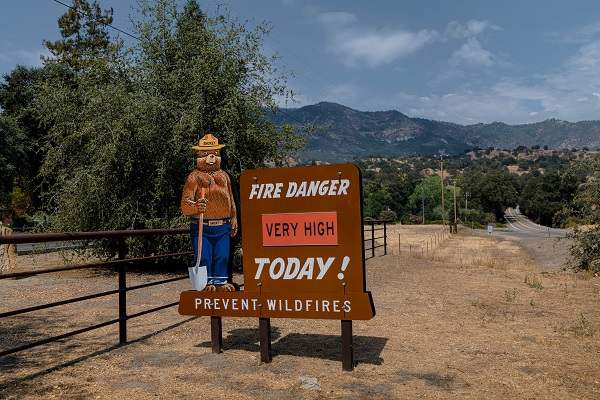
A sign outside of Kings Canyon National Park informs visitors that the park is at a very high risk for fire
‘This is unacceptable’
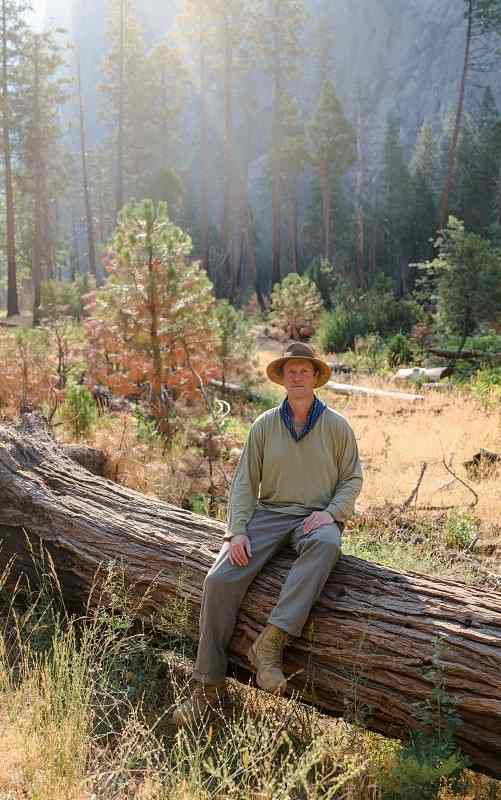
Wildfire ecologist Chad Hanson in Yosemite National Park. Hanson and other ecologists recently sued Yosemite for logging trees within a National Park.
Chad Hanson climbed onto a stump that was more than five feet across. He knelt down and ran his hand slowly across the tree rings. All around him were stumps, hundreds of freshly cut firs and pines in the Merced Grove inside Yosemite. Logs by the dozen had been stacked in piles, ready for removal to be sold for lumber or burned in power plants for electricity. The churned up earth from the treads of heavy machinery stretched into the distance.
“The people who did this should not be running a national park,” Hanson said bitterly. “They’re literally clear-cutting large swaths of the Merced Grove. This is unacceptable.”
Hanson, a 55-year-old ecologist, is co-founder of the John Muir Project, a subsidiary of the Earth Island Institute, which brought the lawsuit against Yosemite.
Hanson is primarily opposed to cutting trees as a strategy to manage wildfires. He believes “thinning” and “fuel reduction” are euphemisms for commercial logging – a point made in a letter last year to Biden signed by Hanson and 200 other experts warning against these practices in the infrastructure bill. He also believes cutting trees does not slow or contain fires and can accelerate them, by opening the canopy and drying out forests, and leaving behind flammable debris and grasses.
“This is not a fuel break,” Hanson said as he stood in the 200-foot-wide newly logged corridor in Yosemite. “This is actually a place where the fire will whip through more rapidly and more intensively.”
A review of the scientific literature on key questions about fire management tools published last year found that thinning, removing fuels, and using prescribed fires, can be effective at lessening the severity of wildfires under certain conditions, although they’re not appropriate in all types of forests and if done incorrectly can aggravate the problem.
In environmental circles, Hanson is a controversial figure. Other scientists have challenged his methodology and accused him, in their own studies, of misusing data on issues such as how wildfires affect spotted owls and the effectiveness of forest thinning. One of those rebuttals described the work of Hanson and others as having “garnered substantial attention and fostered confusion about the best available science.”
“I’m not in favor of anything he does, or says,” said Bernal, the Berkeley researcher, who has studied sequoia regeneration in some of the same groves where Hanson has worked, calling it “agenda-driven” and “biased.”
Hanson, for his part, defends his science and says his opponents are often funded by pro-logging interests. He called the work of Bernal and others “scientific fraud” that relies on early 20th century tree surveys that he claims lowballed density.
Hanson is among those who believe extreme weather driven by climate change – high winds, intense drought, punishing heat – drives wildfires, and those forces far outstrip our ability to prepare forests to withstand them. He feels government funds should be spent protecting communities and hardening homes, while letting fire move naturally through forests.
Sequoia researchers, including Hanson, agree that fire is necessary and beneficial for sequoias and their ecosystems more broadly. Fibrous, air-filled bark that can be more than two feet thick has evolved to help insulate the trees from flames. Heat opens up sequoia cones, releasing a flurry of oatmeal flake-sized seeds onto the scorched forest floor – a newly-cleared, mineral rich ash that is ideal for germination.
Hanson differs from other scientists in that he’s less disturbed by what the most intense wildfires are doing to sequoias. He sees the recent megafires as a historical correction, something closer to the pre-colonial state when Native Americans managed ecosystems with frequent wildfire. He believes sequoia mortality has been far less than official estimates and new trees can regenerate despite fires’ rising intensity.
On a recent day, Hanson hiked through the Freeman Creek Grove, which burned in the 2020 Castle fire. A study last year by Stephenson, of the USGS, and Christy Brigham, chief of resources at Sequoia and Kings Canyon National Parks, found that the fire killed as many as 10,000 large sequoias – wiping out up to 14% of all large sequoias across its natural range in the Sierra Nevada.
Hanson prefers to see the stag forests as vibrant ecosystems of their own – the charred trees a habitat for woodpeckers, beetles, and the veiled polypore, small white mushrooms that appear after fires on black trunks. In one portion of the forest, where the fire killed most of the trees, Hanson crouched on the ground, excitedly pointing out all the sequoia seedlings dotting the forest floor.
“This is sequoia regeneration. Sequoia regeneration. Sequoia, sequoia, sequoia,” he said. “I’d say at least 1,000 seedlings per acre in here.”
Stephenson agrees hot fires spur reproduction, but said some portions of the Castle Fire footprint burned so hot that cones burned up and new sequoias aren’t regenerating. In such areas, the Park Service plans to plant seedlings by hand.
Hanson believes government officials should not try to prevent wildfires from passing through sequoia groves – including famous tourist attractions.
“They’re treating them as museum pieces. These trees are not our pets,” he said. “What they should be doing is embracing the ecology of this area and telling that to tourists. That this is part of the natural life cycle of giant sequoias.”
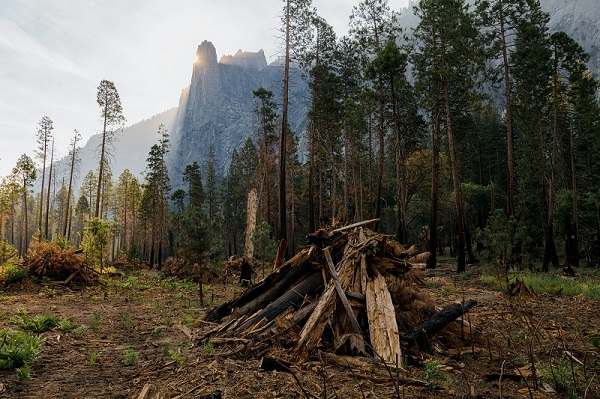
A patch of forest in Yosemite National Park recently underwent a prescribed burn and logging.
‘The proof’
When the Washburn fire broke out on the afternoon of July 7, there were 2,700 people visiting the Mariposa Grove. The grove had always been a draw. It was photographs of these trees – some 500 towering sequoias – that convinced Abraham Lincoln to conserve this land in 1864, establishing protections that helped launch America’s national parks.
There was no lightning that day; authorities suspect humans caused the fire. When flames began roaring upslope toward the grove, Yosemite’s firefighters had two urgent tasks: Evacuate tourists, and save the trees. Park staff raced to clear the trail and herd tourists onto shuttle buses to escape out the only road into the grove.
“They were in really tight, as many people as we could squeeze into those shuttles,” Kelly Singer, the park’s deputy fire management officer, recalled. “They were driving right by the fire.”
In some ways, the park was well prepared for that moment. Within the grove, Yosemite has conducted 21 prescribed fires since 1971, creating a patchwork of forest where flames have periodically cleared out understory bushes and smaller trees. Three times since 2017, Dickman and others had rushed to the grove for emergency prep work – clearing logs and branches away from the base of sequoias.
As the fire closed in on the grove, Dickman and others did this work on about 100 sequoias. For the most famous tree – the Grizzly Giant – staff ringed it with sprinklers, supplied by a 1,500-gallon water tank.
The Washburn fire scorched a few sequoias but killed none. Firefighters said they watched as flames that were dozens or hundreds of feet tall drop to a couple of feet when they hit areas recently treated with prescribed fire.
At a community meeting, David Conway, the director of environmental health for Mariposa County approached Singer, the fire officer, to say the work firefighters had done in prescribed burns saved the community of Wawona, “as much as a pain in the a– I was over most of that stuff.”
Conway gets complaints from the public when smoke from prescribed fires muddies the air. In the past, his office has postponed such fires because of air quality concerns. But he “absolutely” believes the work saved people’s homes.
“When it came up against those old burn scars, where prescribed fire was done or other fires have occurred, it slowed down dramatically,” he said.
Dickman believes the park’s treatments saved the giant sequoias. The Mariposa Grove, after being closed a month, reopened on Aug. 3.
“That’s why we’ve been doing prescribed fire for 50 years. We’ve known that would be the thing that’s going to save them,” he said. “But that was really the proof.”





